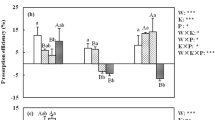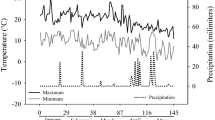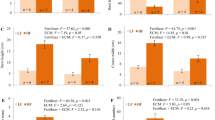Abstract
Nutrient retranslocation from senescing foliage to perennial organs is critical for nutrient conservation and a mechanism of plant adaptation to low-fertility soils. And it has been well documented for evergreen species and for deciduous broadleaf tree species. Meanwhile, subirrigation (SI) and fertilization are used to improve the production efficiency of seedlings, however, little is known about how retranslocation in deciduous conifer seedlings is affected by SI or soil fertility. We fertilized Larix principis-rupprechtii Mayr seedlings with 50, 100, and 150 mg N per seedling using SI and overhead irrigation (OI). Seedling growth and nutrient status, at both pre-senescence (T1) and post-abscission (T2) moments, and growing media electrical conductivity were measured to (1) explore relationships between foliar nutrient retranslocation and (a) growth, (b) nutrient status, and (c) media fertility, and (2) examined how these are affected by irrigation method and fertilizer rate. Fertilizer rate and irrigation method had little effect on seedling growth, with the exception of root mass, but N, P, and K concentrations increased with increasing soil fertility and both concentrations and contents were greater under SI compared to OI. Foliar N and K retranslocation was lower under SI compared to OI across all fertilizer rates, while foliar P retranslocation was lower only at the highest fertilizer rate for SI-seedlings. For OI-seedlings, retranslocation was unaffected by fertilizer rate, with average N, P, and K retranslocation efficiencies of 71%, 29%, and 55%, respectively. However, retranslocation in SI-seedlings declined as fertilizer rates increased. Foliar nutrient retranslocation directly correlated with seedling biomass accumulation over the growing season (up to T1) and inversely correlated with soil fertility, shoot biomass accumulation during hardening (from T1 to T2), and T1 nutrient concentration in roots (N, P, and K) and stems (N and K). Understanding nutrient retranslocation dynamics for deciduous woody plants informs more effective nutrient management regimes for seedling production under SI.






Similar content being viewed by others
References
Aerts R (1996) Nutrient resorption from senescing leaves of perennials: are there general patterns? J Ecol 84:597–608. https://doi.org/10.2307/2261481
Argo WR, Biernbaum JA (1995) The effect of irrigation method, water-soluble fertilization, preplant nutrient charge, and surface evaporation of early vegetative and root growth of poinsettia. J Am Soc Hortic Sci 120(2):163–169. https://doi.org/10.21273/JASHS.120.2.163
Bumgarner ML, Salifu KF, Jacobs DF (2008) Subirrigation of Quercus rubra seedlings: nursery stock quality, media chemistry, and early field performance. Hortscience 43(7):2179–2185. https://doi.org/10.21273/HORTSCI.43.7.2179
Bumgarner ML, Salifu KF, Mickelbart MV, Jacobs DF (2015) Effects of fertilization on media chemistry and Quercus rubra seedling development under subirrigation. Hortscience 50(3):454–460. https://doi.org/10.21273/HORTSCI.50.3.454
Carlyle JC, Malcolm DC (1986) Larch litter and nitrogen availability in mixed larch-spruce stands. I. Nutrient withdrawal, retranslocation, and leaching loss from larch at senescence. Can J For Res 16:321–326. https://doi.org/10.1139/x86-054
Chapin FS, Moilanen I (1991) Nutritional controls over nitrogen and phosphorus resorption from alaskan birch leaves. Ecology 72(2):709–715. https://doi.org/10.2307/2937210
Cheng L, Fuchigami LH (2002) Growth of young apple trees in relation to reserve nitrogen and carbohydrates. Tree Physiol 22(18):1297. https://doi.org/10.1093/treephys/22.18.1297
Cox D (2001) Growth, nutrient content, and growth medium electrical conductivity of poinsettia irrigated by subirrigation or from overhead. J Plant Nutr 24(3):11. https://doi.org/10.1081/PLN-100104977
Davis AS, Jacobs DF, Overton RP, Dumroese RK (2008) Influence of irrigation method and container type on northern red oak seedling growth and media electrical conductivity. Nativ Plants J 9(1):5–12. https://doi.org/10.2979/NPJ.2008.9.1.4
Davis AS, Aghai MM, Pinto JR, Apostol KG (2011) Growth, gas exchange, foliar nitrogen content, and water use of subirrigated and overhead-irrigated Populus tremuloides Michx. seedlings. Hortscience 46(9):1249–1253. https://doi.org/10.21273/HORTSCI.46.9.1249
de las Heras J, Hernández-Tecles E, Moya D (2017) Seasonal nutrient retranslocation in reforested Pinus halepensis Mill. stands in Southeast Spain. New For 48(3):1–17. https://doi.org/10.1007/s11056-016-9564-2
Duchesne L, Ouimet R, Claude C, Houle D (2001) Seasonal nutrient transfers by foliar resorption, leaching, and litter fall in a northern hardwood forest at Lake Clair Watershed, Quebec, Canada. Can J For Res 31(2):333–344. https://doi.org/10.1139/x00-183
Dumroese RK, Page-Dumroese DS, Salifu KF, Jacobs DF (2005) Exponential fertilization of Pinus monticola, seedlings: nutrient uptake efficiency, leaching fractions, and early outplanting performance. Can J For Res 35(12):2961–2967. https://doi.org/10.1139/x05-226
Dumroese RK, Davis AS, Jacobs DF (2011) Nursery response of acacia koa seedlings to container size, irrigation method, and fertilization rate. J Plant Nutr 34(6):877–887. https://doi.org/10.1080/01904167.2011.544356
Dumroese RK, Pinto JR, Montville ME (2015) Using container weights to determine irrigation needs: a simple method. Nativ Plants J 16:67–71
Fife DN, Nambiar EKS (1997) Changes in the canopy and growth of Pinus radiata in response to nitrogen supply. For Ecol Manage 93(1–2):137–152. https://doi.org/10.1016/S0378-1127(96)03917-5
Fife DN, Nambiar EKS, Saur E (2008) Retranslocation of foliar nutrients in evergreen tree species planted in a Mediterranean environment. Tree Physiol 28(2):187–196. https://doi.org/10.1093/treephys/28.2.187
Gower ST, Richards JH (1990) Larches: deciduous conifers in an evergreen world. Bioscience 40:818–826. https://doi.org/10.2307/1311484
Gower ST, Grier CC, Vogt KA (1989) Aboveground production and N and P use by Larix occidentalis and Pinus contorta in the Washington Cascades, USA. Tree Physiol 5:1–11. https://doi.org/10.1093/treephys/5.1.1
Helmisaari HS (1992) Nutrient retranslocation within the foliage of Pinus sylvestris. Tree Physiol 10(1):45–58. https://doi.org/10.1093/treephys/10.1.45
Jacobs DF, Timmer VR (2005) Fertilizer-induced changes in rhizosphere electrical conductivity: relation to forest tree seedling root system growth and function. New For 30(2–3):147–166. https://doi.org/10.1007/s11056-005-6572-z
Jentschke G, Brandes B, Kuhn AJ, Godbold WHSL (2001) Interdependence of phosphorus, nitrogen, potassium and magnesium translocation by the ectomycorrhizal fungus Paxillus involutus. New Phytol 149(2):327–337. https://doi.org/10.1046/j.1469-8137.2001.00014.x
Johnson DW, Cole DW, Bledsoe CS, Cromack K, Edmonds RL, Gessel SP, Grier CC, Richards BN, Vogt KA (1982) Nutrient cycling in forests of the Pacific Northwest [Ecosystem productivity, soil leaching processes]. US/IBP Synthesis Series, pp 186–232
Klock-Moore KA, Broschat TK (2000) Use of subirrigation to reduce fertilizer runoff. Proc Flor State Hortic Soc 113:149–151
Kobe RK, Lepczyk CA, Iyer LM (2005) Resorption efficiency decreases with increasing green leaf nutrients in a global data set. Ecology 86(10):2780–2792. https://doi.org/10.1890/04-1830
Landis TD (1989) Mineral nutrients and fertilization. In: Landis TD, Tinus RW, McDonald SE, Barnett JP (eds) The container tree nursery manual, Volume 4. Seedling nutrient and irrigation. Agriculture Handbook. Department of Agriculture Forest Service, Washington, DC, pp 23–25
Li GL, Liu Y, Zhu Y, Li QM, Dumroese RK (2012) Effect of fall- applied nitrogen on growth, nitrogen storage, and frost hardiness of bareroot Larix olgensis seedlings. Silva Fenn 46:345–354
Li G, Zhu Y, Liu Y, Wang J, Liu J, Dumroese RK (2014) Combined effects of pre-hardening and fall fertilization on nitrogen translocation and storage in Quercus variabilis seedlings. Eur J For Res 133(6):983–992. https://doi.org/10.1007/s10342-014-0816-4
Liu Y, Bai SL, Zhu Y, Li GL, Jiang P (2012) Promoting seedling stress resistance through nursery techniques in China. New For 43(5–6):639–649. https://doi.org/10.1007/s11056-012-9341-9
Lowther JR (1980) Use of a single sulphuric acid-hydrogen peroxide digest for the analysis of Pinus radiata needles. Commun Soil Sci Plant Anal 11:175–188. https://doi.org/10.1080/00103628009367026
Lü XT, Reed SC, Yu Q, Han XG (2016) Nutrient resorption helps drive intra-specific coupling of foliar nitrogen and phosphorus under nutrient-enriched conditions. Plant Soil 398(1–2):111–120. https://doi.org/10.1007/s11104-015-2642-y
Machado MR, Sampaio PTB, Ferraz J, Camara R, Pereira MG (2016) Nutrient retranslocation in forest species in the Brazilian Amazon. Acta Sci Agron 38(1):93–101. https://doi.org/10.4025/actasciagron.v38i1.26805
Millard P, Grelet GA (2010) Nitrogen storage and remobilization by trees: ecophysiological relevance in a changing world. Tree Physiol 30(9):1083–1095. https://doi.org/10.1093/treephys/tpq042
Millard P, Proe MF (1991) Leaf demography and the seasonal internal cycling of nitrogen in sycamore (Acer pseudoplatanus l.) seedlings in relation to nitrogen supply. New Phytol 117(4):587–596. https://doi.org/10.1111/j.1469-8137.1991.tb00963.x
Millard P, Thomson CM (1989) The effect of the autumn senescence of leaves on the internal cycling of nitrogen for the spring growth of apple trees. J Exp Bot 40(220):1285–1289
Millard P, Wendler R, Grassi G, Grelet GA, Tagliavini M (2006) Translocation of nitrogen in the xylem of field-grown cherry and poplar trees during remobilization. Tree Physiol 26(4):527–536. https://doi.org/10.1093/treephys/26.4.527
Millett J, Millard P, Hester AJ, Mcdonald AJS (2005) Do competition and herbivory alter the internal nitrogen dynamics of birch saplings? New Phytol 168(2):413–422. https://doi.org/10.1111/j.1469-8137.2005.01510.x
Nambiar EKS, Fife DN (1991) Nutrient retranslocation in temperate conifers. Tree Physiol 9:185–207
Norris MD, Reich PB (2009) Modest enhancement of nitrogen conservation via retranslocation in response to gradients in N supply and leaf N status. Plant Soil 316(1–2):193–204. https://doi.org/10.1007/s11104-008-9770-6
Ostman NL, Weaver GT (1982) Autumnal nutrient transfers by retranslocation, leaching and litter fall in a chestnut oak forest in southern Illinois. Can J For Res 12(12):40–51. https://doi.org/10.1139/x82-006
Salifu KF, Timmer VR (2003) Optimizing nitrogen loading of Picea mariana seedlings during nursery culture. Can J For Res 33(7):1287–1294. https://doi.org/10.1139/x03-057
Saur E, Nambiar EKS, Fife DN (2000) Foliar nutrient retranslocation in Eucalyptus globulus. Tree Physiol 20(16):1105–1112. https://doi.org/10.1093/treephys/20.16.1105
Scoggins HL, Van Iersel MW (2006) In situ probes for measurement of electrical conductivity of soilless substrates: effects of temperature and substrate moisture content. Hortscience 41(1):210–214. https://doi.org/10.21273/HORTSCI.41.1.210
Shi W, Grossnickl SC, Li G, Su S, Liu Y (2018) Fertilization and irrigation regimes influence on seedling attributes and field performance of Pinus tabuliformis Carr. Forestry 92(1):97–107. https://doi.org/10.1093/forestry/cpy035
Son Y, Gower ST (1991) Aboveground nitrogen and phosphorus use by five plantation-grown trees with different leaf longevities. Biogeochemistry (Dordrecht) 14(3):167–191
Son Y, Lee IK, Ryu SR (2000) Nitrogen and phosphorus dynamics in foliage and twig of pitch pine and Japanese larch plantations in relation to fertilization. J Plant Nutr 23(5):697–710. https://doi.org/10.1080/01904160009382051
Soto R (1992) Nutrient concentration and retranslocation in coastal vegetation and mangroves from the Pacific coast of Costa Rica. Brenesia 37:33–50
Sun Q, Dumroese RK, Liu Y (2018) Container volume and subirrigation schedule influence Quercus variabilis seedling growth and nutrient status in the nursery and field. Scand J For Res 33(6):560–567. https://doi.org/10.1080/02827581.2018.1444787
Tilton DL (1977) Seasonal growth and foliar nutrients of Larix laricina in three wetland ecosystems. Can J Bot 55(55):1291–1298. https://doi.org/10.1139/b77-150
Villar-Salvador P, Heredia N, Millard P (2009) Remobilization of acorn nitrogen for seedling growth in holm oak (Quercus ilex), cultivated with contrasting nutrient availability. Tree Physiol 30(2):257–263. https://doi.org/10.1093/treephys/tpp115
Villar-Salvador P, Uscola M, Jacobs DF (2015) The role of stored carbohydrates and nitrogen in the growth and stress tolerance of planted forest trees. New For 46(5):813–839. https://doi.org/10.1007/s11056-015-9499-z
Wan F, Liu Y, Li G, Sun Q, Jiang L, Shi W, Teng F, Zhang J (2017) Effect of subirrigation with slow-release fertilizer on growth and accumulation of nitrogen of Larix principis-rupprechtii Mayr container seedlings. J Nanjing For Univ 41(01):75–81. https://doi.org/10.3969/j.issn.1000-2006.2017.01.012
Wan F, Ross-Davis AL, Shi W, Weston C, Song X, Chang X, Davis AS, Liu Y, Teng F (2019) Subirrigation effects on Larch seedling growth, root morphology, and media chemistry. Forests 10(1):38. https://doi.org/10.3390/f10010038
Wang WQ, Wang M, Lin P (2003) Seasonal changes in element contents in mangrove element retranslocation during leaf senescence. Plant Soil 252(2):187–193. https://doi.org/10.1023/A:1024704204037
Xi W, Liu Y, Ma L, Li G, Jia Z, Lou J, Hu J, Wang Y (2015) Effects of sub-irrigation with different water and fertilizer supplies on growth, media pH and electric conductance of containerized Larix principis-rupprechtii seedlings. Sci Silvae Sin 51(6):36–43. https://doi.org/10.11707/j.1001-7488.20150605
Zhu Y, Dumroese RK, Pinto JR, Li GL, Liu Y (2013) Fall fertilization enhanced nitrogen storage and translocation in Larix Olgensis seedlings. New For 44(6):849–861. https://doi.org/10.1007/s11056-013-9370-z
Acknowledgments
I am very grateful to the experimental equipment provided by College of Forestry, Beijing Forestry University, the guidance of the laboratory staff. Thank other lab-mates for helping with the experiment, and the staff in Jiufeng for managing the nursery.
Funding
This study was funded by the “948” Plan of China (2012-4-66), Short-term International Student Program for Postgraduates of Forestry First-Class Discipline (2019XKJS0501).
Author information
Authors and Affiliations
Contributions
Conceptualization: YL, FW; Methodology: YL, FW; Formal analysis and investigation: FW, ALR-D, XS, XC, JZ; Writing—original draft preparation: FW; Writing—review and editing: ALR-D, FW, YL, ASD; Funding acquisition: YL; Resources: YL; Supervision: YL, ASD.
Corresponding author
Ethics declarations
Conflict of interest
None declared.
Additional information
Publisher's Note
Springer Nature remains neutral with regard to jurisdictional claims in published maps and institutional affiliations.
Electronic supplementary material
Below is the link to the electronic supplementary material.
Rights and permissions
About this article
Cite this article
Wan, F., Ross-Davis, A.L., Davis, A.S. et al. Nutrient retranslocation in Larix principis-rupprechtii Mayr relative to fertilization and irrigation. New Forests 52, 69–88 (2021). https://doi.org/10.1007/s11056-020-09783-5
Received:
Accepted:
Published:
Issue Date:
DOI: https://doi.org/10.1007/s11056-020-09783-5




